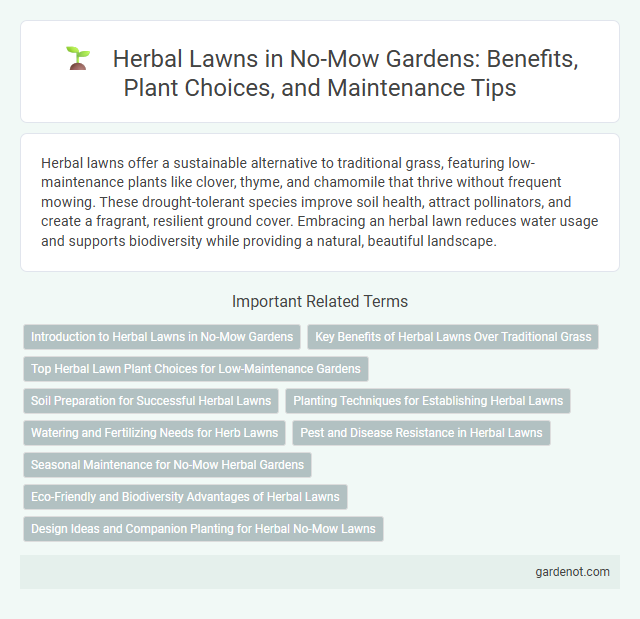Herbal lawns offer a sustainable alternative to traditional grass, featuring low-maintenance plants like clover, thyme, and chamomile that thrive without frequent mowing. These drought-tolerant species improve soil health, attract pollinators, and create a fragrant, resilient ground cover. Embracing an herbal lawn reduces water usage and supports biodiversity while providing a natural, beautiful landscape.
Introduction to Herbal Lawns in No-Mow Gardens
Herbal lawns consist of low-growing, flowering herbs such as chamomile, thyme, and clover, offering vibrant textures and colors without the need for regular mowing. These drought-resistant plants improve soil health by fixing nitrogen and attracting beneficial pollinators, enhancing garden biodiversity. Implementing herbal lawns reduces maintenance time and dependence on fertilizers, promoting eco-friendly landscaping practices.
Key Benefits of Herbal Lawns Over Traditional Grass
Herbal lawns offer superior drought resistance and require significantly less water compared to traditional grass, making them ideal for sustainable landscaping. Their diverse plant species enhance soil health and support local biodiversity by providing habitats for pollinators and beneficial insects. Maintenance demands are lower due to reduced mowing frequency and minimal fertilizer use, leading to cost savings and a smaller environmental footprint.
Top Herbal Lawn Plant Choices for Low-Maintenance Gardens
Herbal lawns featuring thyme, chamomile, and creeping rosemary offer drought-resistant and low-maintenance alternatives to traditional grass, thriving in poor soil and requiring minimal mowing. These herbs provide fragrant, soft ground cover that attracts pollinators and enhances biodiversity while reducing water and fertilizer needs. Choosing such hardy perennial herbs optimizes garden sustainability and creates vibrant, eco-friendly green spaces with minimal upkeep.
Soil Preparation for Successful Herbal Lawns
Effective soil preparation is essential for establishing a thriving herbal no-mow lawn, focusing on improving soil structure, fertility, and drainage. Incorporate organic matter such as compost or well-rotted manure to enhance microbial activity and nutrient availability. Soil pH should be tested and adjusted to a slightly acidic to neutral range (6.0-7.0) to promote optimal growth of herbal species like chamomile, clover, and thyme.
Planting Techniques for Establishing Herbal Lawns
Planting techniques for establishing herbal lawns involve choosing drought-resistant and low-maintenance herbs such as thyme, chamomile, and clover to create a resilient ground cover. Preparing the soil by aerating and adding organic compost enhances herb root development and moisture retention. Direct seeding or transplanting young herb plugs during early spring ensures optimal establishment and long-term weed suppression.
Watering and Fertilizing Needs for Herb Lawns
Herb lawns require significantly less watering than traditional grass, thriving with deep, infrequent watering that encourages strong root development. Fertilization needs are minimal, often satisfied by organic compost or slow-release, low-nitrogen fertilizers to maintain soil health without promoting excessive leaf growth. This sustainable approach reduces water consumption and chemical inputs, supporting a resilient, drought-tolerant herbal landscape.
Pest and Disease Resistance in Herbal Lawns
Herbal lawns, composed of diverse low-growing herbs such as thyme, clover, and chamomile, exhibit strong pest and disease resistance due to their natural compounds that repel common lawn pests and inhibit fungal growth. These hardy species reduce the need for chemical pesticides, promoting an eco-friendly and sustainable lawn care approach. Their dense growth habit also minimizes bare soil, lowering the risk of weed invasion and soil-borne diseases.
Seasonal Maintenance for No-Mow Herbal Gardens
Herbal no-mow gardens require minimal seasonal maintenance, focusing on pruning, mulching, and soil health to sustain plant vitality year-round. Regular trimming of herbs like thyme, chamomile, and creeping rosemary encourages dense growth and prevents overcrowding without the need for mowing. Applying organic mulch in spring and fall conserves moisture, suppresses weeds, and enriches the soil, promoting a resilient, low-maintenance herbal lawn.
Eco-Friendly and Biodiversity Advantages of Herbal Lawns
Herbal lawns enhance eco-friendly landscaping by reducing the need for chemical fertilizers and pesticides, promoting healthier soil ecosystems. These lawns support biodiversity by providing habitat and food sources for pollinators like bees and butterflies, boosting local wildlife populations. Low maintenance requirements further decrease carbon emissions from lawn equipment, making herbal lawns a sustainable choice for environmentally conscious homeowners.
Design Ideas and Companion Planting for Herbal No-Mow Lawns
Herbal no-mow lawns thrive with diverse companion planting, incorporating low-growing herbs like thyme, chamomile, and creeping rosemary to create a fragrant, textured ground cover that requires minimal maintenance. Design ideas emphasize blending varying leaf colors, textures, and aromatic profiles to enhance visual appeal and support pollinators while suppressing weeds naturally. Strategic placement of nitrogen-fixing legumes such as clover improves soil health and sustainability, fostering a resilient, eco-friendly herbal lawn ecosystem.
Herbal lawn Infographic

 gardenot.com
gardenot.com